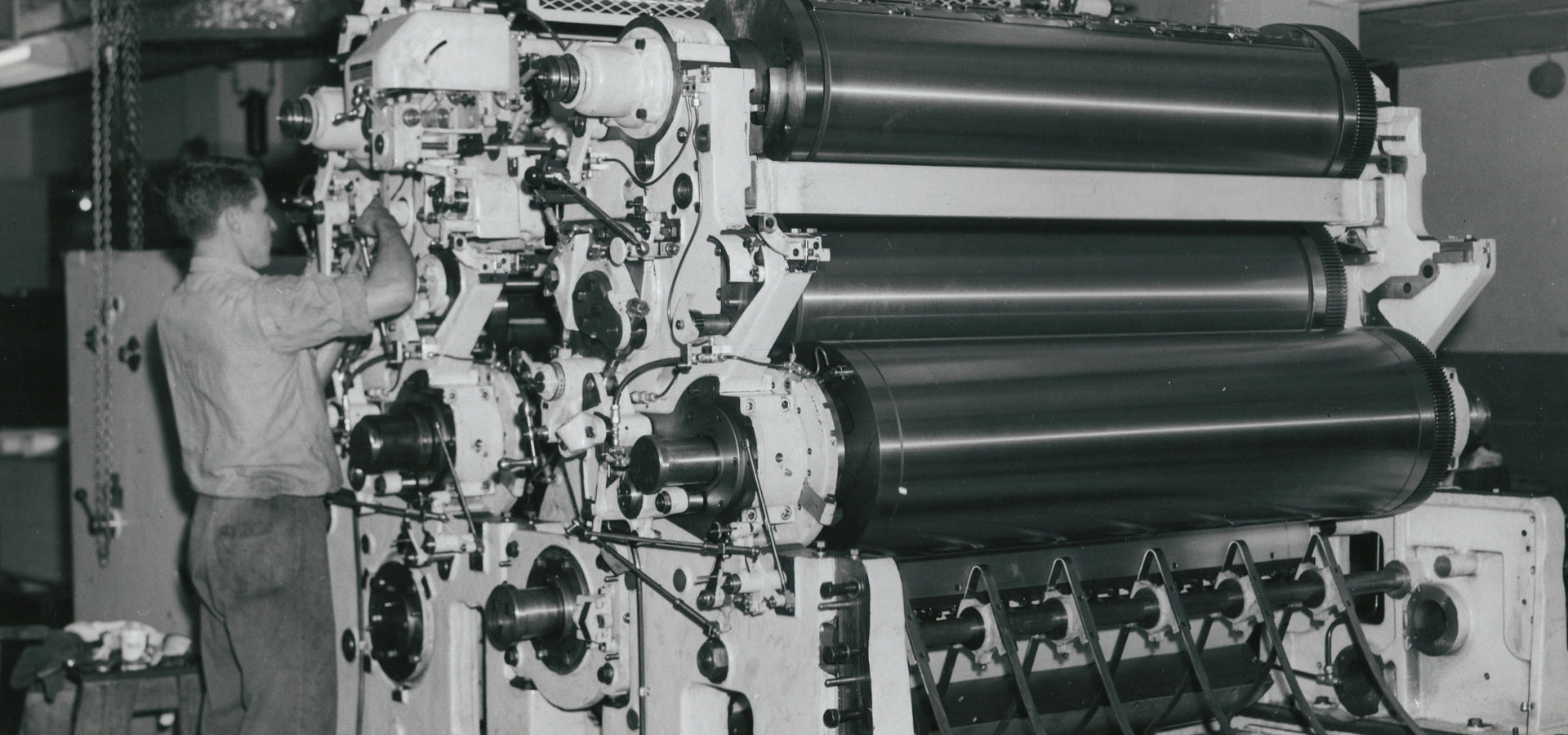
The Printing Press: Revolutionising Information, Art, and Industry
The printing press is one of the most significant inventions in human history. It revolutionised the way information was produced, disseminated, and consumed, leading to a profound impact on society, culture, and commerce. In this article, we will explore the origins of the printing press, its impact on the industry, and some examples of its influence.
The origins of the printing press can be traced back to ancient China, where woodblock printing was used as early as the 7th century. This method involved carving a design into a block of wood, inking the block, and then pressing it onto paper or fabric to create a print. Over time, woodblock printing spread to other parts of Asia and Europe, but it was a time-consuming and labor-intensive process.
The invention of the printing press in the 15th century changed everything. Johannes Gutenberg, a German goldsmith and inventor, developed the first movable type printing press in 1440. This invention allowed for the mass production of printed materials, making it possible to produce books, newspapers, and other printed materials more quickly and efficiently than ever before.
The impact of the printing press was profound. It made books more widely available to people around the world, leading to an increase in literacy and knowledge sharing. Books that were once scarce and expensive became more affordable and accessible, leading to an explosion of ideas and innovations. The printing press also had a significant impact on the art industry, making it possible to reproduce artwork in large quantities.
One example of the printing press's impact on the art industry is the rise of art prints. Before the printing press, reproducing artwork was a time-consuming and expensive process. Artists had to rely on skilled artisans to produce copies of their work, limiting the number of reproductions that could be made. With the printing press, it became possible to produce high-quality reproductions of artwork quickly and affordably.
Art prints allowed people to enjoy beautiful and meaningful works of art in their homes and offices, without the need for a large budget or the ability to travel to museums and galleries. Some of the most famous art prints include Vincent van Gogh's "Starry Night" and Leonardo da Vinci's "Mona Lisa."
The printing press also had a significant impact on the newspaper industry. Before the printing press, newspapers were produced by hand, making them expensive and limited in scope. With the printing press, newspapers could be produced more quickly and efficiently, making them more affordable and widely available. This led to an increase in the dissemination of news and information, allowing people to stay informed about current events and trends.
The printing press is one of the most significant inventions in history. It revolutionised the way information was produced, disseminated, and consumed, leading to a profound impact on society, culture, and commerce. From the rise of art prints to the explosion of ideas and innovations, the printing press has left an indelible mark on the world, changing the way we live, work, and create.
The origins of the printing press can be traced back to ancient China, where woodblock printing was used as early as the 7th century. This method involved carving a design into a block of wood, inking the block, and then pressing it onto paper or fabric to create a print. Over time, woodblock printing spread to other parts of Asia and Europe, but it was a time-consuming and labor-intensive process.
The invention of the printing press in the 15th century changed everything. Johannes Gutenberg, a German goldsmith and inventor, developed the first movable type printing press in 1440. This invention allowed for the mass production of printed materials, making it possible to produce books, newspapers, and other printed materials more quickly and efficiently than ever before.
The impact of the printing press was profound. It made books more widely available to people around the world, leading to an increase in literacy and knowledge sharing. Books that were once scarce and expensive became more affordable and accessible, leading to an explosion of ideas and innovations. The printing press also had a significant impact on the art industry, making it possible to reproduce artwork in large quantities.
One example of the printing press's impact on the art industry is the rise of art prints. Before the printing press, reproducing artwork was a time-consuming and expensive process. Artists had to rely on skilled artisans to produce copies of their work, limiting the number of reproductions that could be made. With the printing press, it became possible to produce high-quality reproductions of artwork quickly and affordably.
Art prints allowed people to enjoy beautiful and meaningful works of art in their homes and offices, without the need for a large budget or the ability to travel to museums and galleries. Some of the most famous art prints include Vincent van Gogh's "Starry Night" and Leonardo da Vinci's "Mona Lisa."
The printing press also had a significant impact on the newspaper industry. Before the printing press, newspapers were produced by hand, making them expensive and limited in scope. With the printing press, newspapers could be produced more quickly and efficiently, making them more affordable and widely available. This led to an increase in the dissemination of news and information, allowing people to stay informed about current events and trends.
The printing press is one of the most significant inventions in history. It revolutionised the way information was produced, disseminated, and consumed, leading to a profound impact on society, culture, and commerce. From the rise of art prints to the explosion of ideas and innovations, the printing press has left an indelible mark on the world, changing the way we live, work, and create.
People also read
The Ultimate Guide to Choosing Wall Art for Your Kitchen
Selecting the perfect wall art for your kitchen isn’t just about decorating a space; it’s an opportunity to reflect your personality, celebrate your love for cooking, and enhance the ambiance...
Magdalena Abakanowicz: Innovative Textile Art and Sculptures
When we consider the landscape of modern art, certain names stand out not just for their creative genius but for their ability to transform the very fabric of artistic expression....
20 must-see places in the Lake District (+ Tips)
At Noonstead, we believe that nature is not just a source of inspiration but also a vital part of our creative process. Every artwork we create takes route from the...
Eight Essential Pieces of Furniture for Small Spaces
In the ever-evolving landscape of modern living, where urban dwellings often entail limited square footage, the challenge for interior designers is to craft spaces that are both chic and functional....
Cozy Delights for Chilly Days
As winter unfolds its icy embrace, it brings with it a unique charm and a plethora of opportunities to create beautiful memories. Instead of hibernating indoors, why not embrace the...
NYC's Timeless Street Photography
New York City, a bustling metropolis that never sleeps, is a treasure trove for street photographers seeking to capture the raw essence of urban life. In the realm of black...
35 Best Art Museums in the U.S. (You Must Explore)
Discover the crème de la crème of art museums scattered across the nation—35 sanctuaries of creativity, each with its own narrative waiting to be unraveled. No need for a transatlantic...
Feng Shui Masterclass: 20 Tips for Positive Energy and Harmony
Welcome to the art of balanced living – Feng Shui. In this comprehensive guide, we'll delve into the fundamental principles of Feng Shui and explore practical ways to apply them...
What Is Midcentury Modern Style?
Step into the refined simplicity of Mid Century Modern (MCM) design, an enduring aesthetic that has seamlessly transcended time. In this comprehensive guide, we unravel the intricate history, delve into...
10 Expert Tips for a Cozy Home This Autumn
Autumn, with its crisp air and vibrant foliage, invites us to embrace the beauty of change. It's the season when we seek warmth, comfort, and a sense of belonging within...
Explore the Top 50 Home Decor Stores in the UK
In the UK's dynamic world of interior design, innovation and creativity abound. Whether your style leans towards contemporary European elegance, rustic charm, artistic flair, or Scandinavian functionality, the UK's online...
Where Can I Buy High-Quality Art Prints?
Art has the remarkable ability to transform spaces, evoke emotions, and ignite creativity. Whether you're a seasoned art collector or a budding enthusiast, the quest for high-quality art prints is...

























